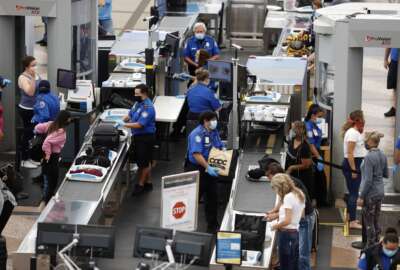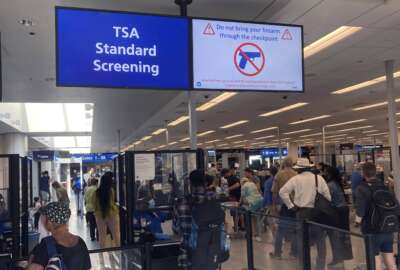
TSA has been around long enough, it has a museum
In the relatively brief 21 years since its inception, the Transportation Security Administration has gone through a lot of change. Everything from its uniforms ...
Best listening experience is on Chrome, Firefox or Safari. Subscribe to Federal Drive’s daily audio interviews on Apple Podcasts or PodcastOne.
In the relatively brief 21 years since its inception, the Transportation Security Administration has gone through a lot of change. Everything from its uniforms to its screening technology has been thought and re-thought. Now TSA has expanded its museum. For details, Federal News Network’s Eric White spoke to TSA’s historian, Heather Farley.
Interview transcript:
Heather Farley
So we created Mission Hall, which is a an on site exhibit celebrating our history and heritage and the creation of the Transportation Security Administration at our new headquarters facility, we moved into our new facility in 2020. And we knew right away that the exhibit was one of the most popular features. So we were really excited to look for opportunities to share it as widely as we could, since we knew not everyone would be able to make it to our headquarters in Springfield, Virginia.Eric White
And what is the Mission Hall itself contain? I know that’s historical commemoration. But can you just tell me a couple of the exhibits that are there?Heather Farley
Yeah, Mission Hall is an exhibit entitled, Remembering the Past Informing the Future. And it’s our flagship display and central to our headquarters facility. It really tells the history of our agency, it includes major milestones, accomplishments and achievements. And it allows us to introduce our workforce to any of our visitors. So we’re really excited to share it as widely as we can.Eric White
What are a couple of those milestones off the top of your head, I’m gonna I’m gonna hold your feet to the fire.Heather Farley
Yeah, so we start off with some early threats to aviation to kind of set the scene for what was happening, the history of aviation security. And then we have a memorial to Sept. 11, which is really the foundational event for TSA. It’s why we were created. So we have a memorial to Sept. 11. And one of our first critical milestones is our anniversary when we were signed into law and created and that’s Nov. 19, 2001. So we start there, and really talk to how the agency was built from the ground up. It was the largest mobilization of the federal government since World War II, we hired 60,000 people in that first year and work to federalize all of the airports across our nation in our first year of existence. So we’re really proud of those achievements.Eric White
And how did the I know that you talked a little bit about it. But how did the virtual tour come about? Obviously, you said, you want to open it up to as many people as possible. But can you talk a little bit about that idea, and what was needed to make that happen?Heather Farley
The idea for the virtual exhibit because we wanted to be able to share our physical exhibit as widely as possible. We knew we wanted something with a really big impact. And that naturally led us to kind of look at digital versions so that anyone with internet or a mobile device would be able to have that same experience of our exhibit.Eric White
I’m curious about these exhibitions, remembering the past for an agency only, you know, a little bit older than two decades, what is the past in TSA look like?Heather Farley
The past in TSA is so foundational for us because we were built out of a really significant world event events of Sept. 11. And those are really critical to how we look at and meet our mission every day. So it’s really valuable for us to look back and understand why we were created. And to remember that our main goal is protecting the transportation system and preventing another attack. And while it’s been 20 years, we’ve had a lot of growth and a lot of evolution over those 20 years. And we want to celebrate those milestones that people understand the successes that we’ve had, in meeting our mission each and every day.Eric White
And informing the future. What is the main message from that exhibition?Heather Farley
Yeah, so history is really so valuable. And it allows us to understand our achievements and where we’ve been. And we use that knowledge to be an incredible tool for planning our future. So we learn from all of our experiences, and we apply those moving forward. We’re really such an agile agency, and we use that to be successful in our daily mission.Eric White
I’m curious, yeah, a lot of agencies use these museums to themselves as a, I guess, a rallying cry for new members. What does TSA do to utilize the Mission Hall itself?Heather Farley
It’s very exciting for us to use virtual Mission Hall because it has widened our audience, we’ve been able to do virtual tours where we host people and give orientations to our new staff members who might not even know why TSA was created. So we have been able to do a really valuable introductions and let people know about why we were created, why our mission is so important and how that has an impact on how we do our work each and every day.Eric White
Yeah, I was wondering because as like, you know, obviously they’re not flying every new TSA agent into Springfield, Virginia. So is this now part of a standard requirement for new TSA agents in their training and onboarding?Heather Farley
Yes, we’ve been working with our, our vast workforce, they have over 60,000 members. You’re absolutely right. Not everyone is at Springfield, Virginia. And this has created this really interactive virtual platform that allows everyone to get an orientation and a historical overview of our major milestones and our historic achievements. Also, some of our, our workforce members, we have a really diverse workforce in the skill set that we have, and what everyone is doing across the agency. Most people think of us as an aviation security agency, but we’re actually doing transportation security across all different areas of responsibility. So it’s been incredibly valuable to introduce our workforce to other colleagues, and to give them the same training and history so that everyone understands where we came from, and has that appreciation for the history of our agency.Eric White
If you don’t mind, I’d like to put the focus a little bit on you for a second, just because it’s such a niche and interesting job. Can you tell me a little bit about your background and how you got here?Heather Farley
Yeah, so I’m a historian, I started out in the museum field. When I first moved to the Washington, D.C. area, I worked at the Smithsonian Institution. And I’ve just organically moved throughout the field, as I am curious about different areas of history. And I’ve really found my passion in federal agency history where we’re celebrating the responsibilities and the work cultures of these very specific agencies and the mission sets that they have. And so it’s been very valuable to work at TSA that has such a focused mission, and really celebrates the workforce culture of the agency.Eric White
Only, you know, 21 years, you know, some may say, that’s not much history, you know, what can a historian look into what was your, I guess, main focus point, when looking into the TSA’s history?Heather Farley
This has been such a unique and powerful opportunity. As a historian, we’re so lucky that most of the people who stood up the agency, and participated in how we were created are still around. And so we’ve been able to do really impactful oral history interviews, we’ve been able to reach out to people to understand how decisions were made and how policies were put into place. And that’s actually quite rare. For a historian, usually, you’re researching things that are 50, 60, 100, several hundred years old, and you’re really reliant on records that were kept. And here, we can really tap into that institutional history of the people, and work with so many of our members that are still at TSA, that has also been so rewarding across our workforce, we have a huge number of people who have been here since TSA was stood up. And it’s really an important time to capture their experiences and their historical achievements. So it’s really been very rewarding for me as a historian, because it’s one of the first times that I’ve been able to work with such a wide array of original sources.Eric White
All right, now you’ve done it, I’m gonna ask you to name drop a few. Anybody that you’ve heard of that you’ve interviewed for the history of TSA?Heather Farley
Now, I’ll have to get back to you on that. I won’t name drop anyone specifically. But I will say that we did a really wonderful film series. And it’s included in this virtual tour, we did a 20th anniversary oral history series, where we talk to the first members of our workforce who are ever hired. They’re lawyers, they’re people who came on board that were transferred from other agencies, and the first members of our mobile screening force, which are the people who federalized the airports from the ground up. And that first year of our TSA, being managing transportation security. And we created a film series of shorts, each with a thematic element. And so we have these interviews, really talking to the evolution of technology, we rely so heavily on technology, what it was like that first year, and those are available right in the tour. So if you want to learn more, you can click on any of our interactive screens and watch our video series to learn more about what our workforce does and what their experiences were like. I just really would love to say that the virtual tour is really geared towards our virtual visitors. So it’s very intuitive and how it’s been built. And it was created to be self paced. So if you just want to walk through and see what our beautiful facility looks like, you can spend a few minutes and if you have more time to invest, you can watch all the videos that we’ve embedded. We have a beautifully written exhibit catalog that includes very detailed history and artifact images. So you can read really invest as much time as you’d like to depending on what your interest is. So I just want to have a one last plug for the really detail level of historic information that we’ve included in this tour for the public.
Copyright © 2024 Federal News Network. All rights reserved. This website is not intended for users located within the European Economic Area.
Tom Temin is host of the Federal Drive and has been providing insight on federal technology and management issues for more than 30 years.
Follow @tteminWFED




